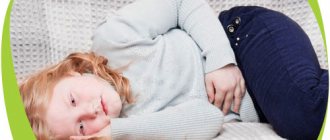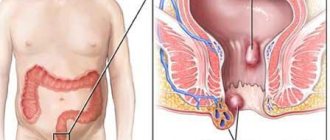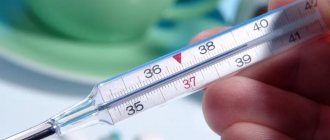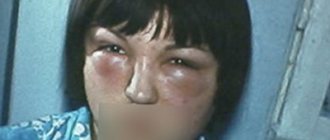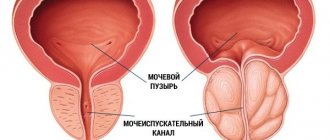November 7, 2018
Rotaviruses, commonly referred to as intestinal infections, are the most common cause of diarrhea in humans and animals. The first line in the risk group is occupied by children - their disease is acute, they are unable to characterize their conditions due to their age, and they are still just learning the basic rules of hygiene, periodically succumbing to the temptation to pet a stray cat, eat strawberries from the garden and not wash their hands.
Once in the body, the “intestinal flu” attacks the cells that line the walls of the gastrointestinal tract and leads to massive damage. The consequence of this is an increase in stool frequency and a watery consistency.
The incidence reaches its peak in the autumn and winter months, when high environmental humidity and decreased immunity of carriers create suitable conditions for the virus to multiply.
In most cases, banal washing of hands and food coming to the table helps prevent food infection. The risk of the disease increases when caring for and other contacts with the “victim” - the patient begins to spread the virus even before the first symptoms appear, and stops several weeks after complete recovery. Even a small number of pathogens can cause the disease.
What is dehydration?
To maintain vital processes, the body needs water and other fluids. This applies to all ages. During the day, the child loses fluid (through sweat, tears, urine and stool) and replaces what is lost with food and drink. Dehydration occurs when a child loses a significant amount of fluid. And if you don't replenish your fluid balance right away, serious complications can occur, including:
- heatstroke
- convulsions
- renal failure
- loss of consciousness
- drop in oxygen levels
How much water does the body need?
There are many opinions on this matter. At the same time, myths appear, following which can be harmful to health. According to experts from the World Health Organization, there cannot be a single standard of water consumption for all people.
Discard unsubstantiated recommendations that you need to drink two to three liters a day or eight glasses, not taking into account tea, coffee and liquids from food. When determining the individual norm, one should rely on body weight and age.
For every kilogram of weight you need:
- children weighing up to 10 kg – 4 ml of water per hour;
- children weighing up to 20 kg – 1000-1500 ml per day;
- adults and adolescents heavier than 20 kg – 1500 ml per day for the first 20 kg + 20 ml for each subsequent kilogram.
If a person weighs 50 kg, then 1500 ml + 20 ml * 30 kg = 2100 ml of liquid per day is required. But you shouldn’t limit or force yourself. You feel thirsty - drink, you can’t swallow another drop - forget about the numbers. The body knows best when it needs water.
Dehydration: symptoms
Signs of dehydration depend on the severity of the condition.
Mild to moderate dehydration: symptoms
Here's how mild to moderate dehydration may appear:
- Deterioration in general health.
- The child has dry mucous membranes in the mouth.
- Paleness of the skin.
- Your baby pees less often (toddlers) or you change fewer than six wet diapers a day (toddlers).
- Crying without tears.
- Sunken eyes.
- Sunken fontanel.
- Loose stools if dehydration is caused by diarrhea, and looser stools if dehydration is caused by vomiting and not drinking enough.
- Increased thirst.
If you notice one of the symptoms in your child, consult a doctor immediately. Your doctor will be able to instruct you on what to do to treat your child's dehydration. For example, buy powder at the pharmacy to prepare a solution that restores water and electrolyte balance, also known as a rehydration solution.
Severe dehydration: symptoms
Here's how severe dehydration may present in a child:
- restless behavior
- excessive sleepiness
- sunken eyes
- cold and pale hands and feet
- wrinkled dry skin
- no wet diapers for eight hours (in infants); does not pee for ten hours (toddlers)
If you think your child is severely dehydrated, call an ambulance immediately. The child may require intravenous rehydration, which may require hospitalization.
Signs of dehydration in a child
Drowsiness, irritability and general lethargy of a child, refusal of favorite games and food - this is an alarming signal for the parent. With rotavirus, it may be accompanied by the following symptoms:
- Dry mucous membranes - dry lips and tongue, dry shine and redness of the eyes.
- Lack of tears when crying.
- Inability to urinate or small volume of urine.
- Skin laxity - Pull your baby's skin between the shoulder blades or on the arm; if it slowly returns to its original state, this indicates severe dehydration.
- Fast weight loss.
- Intense thirst.
Treatment
The goal of treating mild to moderate dehydration at home is to rehydrate by replacing lost fluids. But even with home treatment, if you have questions or doubts, be sure to contact your doctor.
Babies
If your baby is breastfed and is not vomiting, continue breastfeeding to restore fluid balance. But if there is vomiting, you should not put the baby to the breast. The doctor will most likely recommend giving the baby a rehydration solution between feedings and will specify the frequency and duration of administration. If your baby is eating formula, don't give him a bottle of formula, just give him rehydration solution until his body can retain fluid. After this, you can resume formula feeding. Remember that water should not be given to children under six months of age and that water is not suitable for treating dehydration in such young children.
Toddlers
Consult your pediatrician. Your doctor may recommend buying baby powder at the pharmacy to prepare a rehydration solution. Follow the dosage indicated in the instructions. Typically, such solutions are given to children regularly in small doses. What not to give to a small child when he is already dehydrated:
- water
- soda
- tea
- fruit juices
- gelatin desserts
- chicken bouillon
These foods do not contain the necessary sugars and salts that a child needs when dehydrated. And if your child is dehydrated due to diarrhea, these foods and drinks may only make the condition worse.
Is there a tasty remedy for dehydration?
If your child is over three years old, then the INVAR KIDS children's rehydration product, developed in Switzerland, may be a way out of the situation. The soft orange taste of the drink will appeal to your child and will save you from persuasion to take a few sips “for mom and dad.” The product contains everything you need and nothing extra: glucose, potassium, sodium, citrate and chloride. The amount of electrolytes corresponds to WHO recommendations for children. Release form: sachet. All you need to do is dilute the contents of the sachet in a glass of water. An additional bonus from the manufacturer is a cute packaging design that the child will undoubtedly like and remember.
Causes of dehydration
Dehydration in children often occurs with diarrhea, vomiting, or high fever.
Diarrhea
Occasional loose stools are not a cause for concern. But sometimes diarrhea accompanies viral diseases, such as rotavirus. With diarrhea, the child's body loses important minerals, salts, and water in the stool. This can lead to dehydration. If your baby has loose stools every few hours, contact your doctor as soon as possible. The doctor may ask you not to give your baby solid food for 24 hours and to give him a rehydration solution instead.
Vomit
Vomiting can accompany many diseases, including gastroenteritis (stomach flu), and lead to dehydration. To avoid dehydration, it is important to ensure that your child drinks more fluids. If your child continues to vomit, consult a doctor who can give you the appropriate advice. Important: Do not allow your child to eat solid food for the first 24 hours after vomiting starts. Instead, prepare him a rehydration solution.
Heat
If a child has a temperature above 38 degrees, there is a risk of developing dehydration, since fluid loss occurs faster at a temperature. The higher the temperature, the more dehydrated your child may be. Therefore, it is very important that your child drinks more fluids if he or she has a fever.
Sunburn and heatstroke
Severe sunburn and prolonged exposure to heat can also lead to dehydration. If your child has severe sunburn or heatstroke, seek medical attention immediately. Signs of a severe sunburn:
- blisters
- heat
- chills
- headache
- general malaise
- fainting
- dehydration
Rotavirus in children
Children of infant and preschool age are especially vulnerable to the disease, since before the age of 5 the child does not yet have stable immunity. Due to very rapid dehydration compared to adults, diarrhea in children is an indication for urgent hospitalization.
Unwashed hands are the main source of disease, since if hygiene rules are not followed, a person leaves viral particles on common objects (door handles, dishes, etc.). Having a tendency to put objects in their mouths, children have an almost 100% risk of infection. Less commonly, pathogen transmission is facilitated by sneezing or coughing.
The disease is less dangerous for adults, but weakened immunity or old age reduce resistance to it.
How to Avoid Dehydration
If your child is sick, has a fever, has diarrhea, or is vomiting, it is important to make sure they drink plenty of fluids to avoid dehydration. For babies under six months of age, put them to the breast more often; if the baby is bottle-fed, temporarily limit formula feeding and replenish lost fluid with special rehydration solutions. Giving water to such young children is not recommended. If your child has symptoms of mild dehydration, a rehydration solution made from a powder that can be bought over the counter at a pharmacy can help restore the balance of salts and sugars in the body (especially for diarrhea). If you are walking with your child on a hot day, try to stay in the shade as much as possible. Other necessary measures to protect against overheating and sunburn: a wide-brimmed bucket hat, a lightweight long-sleeved cotton T-shirt, and sunscreen. Don't wait until your child starts to feel thirsty; offer him something to drink regularly.
FAQ
- If you notice any of these signs of mild to moderate dehydration in your child, call your doctor immediately:
Deterioration in general health.
- The child has dry mucous membranes in the mouth.
- Pees less often (among toddlers); less than six wet diapers per day (infants)
- Crying without tears.
- Pallor.
- Sunken eyes.
- Sunken fontanel.
- Loose or infrequent stools.
If you notice any of these signs of severe dehydration in your child, call an ambulance:
- Restless behavior.
- Excessive sleepiness.
- Sunken eyes.
- Cold and pale hands and feet.
- Wrinkled dry skin.
- No wet diapers for eight hours (infants); does not pee for ten hours (toddlers).
Follow the dosages indicated in the instructions. If your baby is breastfed, put him to your breast regularly, and give him the solution between feedings. If you usually feed your baby formula, give him only the solution until the signs of dehydration go away. After this, you can offer a bottle of the mixture.
Now you know how dehydration manifests itself, and you can take timely measures if necessary. But the best way to prevent dehydration is to make sure your child drinks enough when sick or when walking on a hot day. Parents of babies are united by the ability to think ahead: for example, what to take with them on a walk for all occasions and for any weather, or how to buy diapers for a month in advance at a discount.
Why are children at risk for dehydration?
Children are more likely to develop fluid deficiency than adults. There are several explanations for this.
In childhood, the immune system has not yet fully matured, which means it does not work effectively enough. Children come into contact with a large number of people - in kindergarten, in transport, on the playground and at matinees. And children do not always carefully follow the rules of hygiene. Consequently, the likelihood of “catching an infection” in children is especially high. Namely, a viral infection is most often accompanied by dehydration.
Therefore, in general, the need for water is higher in childhood.
The skin area relative to weight is larger in children than in adults. Skin breathing is also more intense. This means that by sweating, a child loses more water than an adult.
Finally, young children often cannot communicate their thirst or meet their need for fluids on their own.
How this article was written
The information presented in this article is based on expert advice published by trusted (medical and government) sources such as the American Pediatrics Association and the American College of Obstetricians and Gynecologists. A complete list of links to sources used to write this article can be found at the end of the article. The information on this page is not a substitute for professional medical advice. Always consult your doctor for diagnosis and treatment.
Types and degrees of dehydration
Dehydration should not be allowed. If such a process has begun, then treatment must be carried out urgently, depending on the type and stage. There are three types in total:
- Isotonic (the salt composition of the blood remains normal);
- Hypertensive (increased levels of salts are observed in the blood);
- Hypotonic (low levels of salts are observed in the blood).
Isotonic dehydration can occur as a result of prolonged exposure to the sun. The next two types develop as a result of pathological changes. Dehydration makes itself felt almost immediately, but it can develop over several days, increasing the stage.

